Top Trends in the Commercial Cleaning Industry for 2025
The commercial cleaning industry is constantly evolving, adapting to new technologies, heightened hygiene standards, and a growing focus on sustainability. For 2025, several key trends are poised to reshape how businesses approach cleanliness and sanitation. Understanding these emerging patterns in the commercial cleaning industry is crucial for both cleaning service providers and the organizations they serve. From the integration of advanced robotics to a deeper emphasis on employee well-being, the commercial cleaning industry is undergoing a significant transformation that demands attention and proactive adaptation.
The Rise of Autonomous Cleaning Solutions
One of the most significant trends impacting the industry is the increasing adoption of autonomous cleaning solutions. These robotic systems, equipped with sophisticated sensors and AI, are capable of performing a variety of cleaning tasks with minimal human intervention.
- Floor Scrubbing Robots: These robots can autonomously navigate large spaces, scrubbing and polishing floors with consistent efficiency.
- Vacuuming Robots: Designed for carpets and hard floors, vacuuming robots offer a hands-free cleaning solution, freeing up human cleaners for more complex tasks.
- Disinfection Robots: Utilizing UV-C light or electrostatic spraying, these robots can disinfect surfaces rapidly and effectively, reducing the spread of pathogens.
Sustainability and Eco-Friendly Practices
The growing awareness of environmental issues is driving a strong demand for sustainable cleaning practices. Businesses are increasingly seeking cleaning services that prioritize eco-friendly products and methods.
Key Aspects of Sustainable Cleaning: - Green Cleaning Products: Using cleaning agents that are biodegradable, non-toxic, and free from harsh chemicals.
- Water Conservation: Implementing water-saving techniques, such as using microfiber cloths and efficient cleaning equipment.
- Waste Reduction: Minimizing waste through proper disposal methods, recycling programs, and the use of concentrated cleaning solutions.
Focus on Indoor Air Quality
Beyond surface cleanliness, there’s a growing emphasis on improving indoor air quality (IAQ). Poor IAQ can lead to health problems, reduced productivity, and increased absenteeism. Effective cleaning practices play a crucial role in maintaining a healthy indoor environment.
The Human Element Remains Crucial
While automation and advanced technologies are transforming the commercial cleaning industry, the human element remains paramount. Investing in training, providing fair wages, and prioritizing employee well-being are essential for attracting and retaining skilled cleaning professionals. The industry’s evolution requires a blended approach, combining technological innovation with the expertise and dedication of human cleaners to deliver exceptional results.
Are businesses demanding more rigorous and verifiable cleaning protocols now? Is it no longer sufficient to simply “look clean”? Are we seeing a shift towards data-driven cleaning schedules, where cleaning frequency and intensity are determined by real-time data on occupancy levels, air quality, and surface contamination? Shouldn’t sensors and monitoring systems be used to track key metrics and optimize cleaning efforts? Is this data then used to generate reports and provide insights into the effectiveness of cleaning strategies?
Has the rise of remote work and hybrid office models significantly changed cleaning needs? Are companies re-evaluating their cleaning schedules and focusing on high-traffic areas when employees are present? Are they prioritizing deep cleaning during off-peak hours or weekends? Does the reduced occupancy during the week affect the type of cleaning required, such as increased focus on air purification or targeted disinfection of shared spaces?
Is the commercial cleaning industry facing a labor shortage? Are companies struggling to find and retain qualified cleaning staff? Are they implementing innovative strategies to attract and train new employees, such as offering competitive wages, flexible schedules, and comprehensive training programs? Are virtual reality (VR) or augmented reality (AR) tools being used for training purposes to simulate real-world cleaning scenarios and improve employee skills?
So, as we look towards 2025, shouldn’t we ask ourselves if the future of the commercial cleaning industry depends on embracing these trends, integrating technology, and prioritizing both human health and environmental sustainability?
Enhanced Cleaning Protocols and Data-Driven Insights
Are businesses demanding more rigorous and verifiable cleaning protocols now? Is it no longer sufficient to simply “look clean”? Are we seeing a shift towards data-driven cleaning schedules, where cleaning frequency and intensity are determined by real-time data on occupancy levels, air quality, and surface contamination? Shouldn’t sensors and monitoring systems be used to track key metrics and optimize cleaning efforts? Is this data then used to generate reports and provide insights into the effectiveness of cleaning strategies?
The Impact of Remote Work and Hybrid Offices
Has the rise of remote work and hybrid office models significantly changed cleaning needs? Are companies re-evaluating their cleaning schedules and focusing on high-traffic areas when employees are present? Are they prioritizing deep cleaning during off-peak hours or weekends? Does the reduced occupancy during the week affect the type of cleaning required, such as increased focus on air purification or targeted disinfection of shared spaces?
Addressing Labor Shortages and Training Gaps
Is the commercial cleaning industry facing a labor shortage? Are companies struggling to find and retain qualified cleaning staff? Are they implementing innovative strategies to attract and train new employees, such as offering competitive wages, flexible schedules, and comprehensive training programs? Are virtual reality (VR) or augmented reality (AR) tools being used for training purposes to simulate real-world cleaning scenarios and improve employee skills?
So, as we look towards 2025, shouldn’t we ask ourselves if the future of the commercial cleaning industry depends on embracing these trends, integrating technology, and prioritizing both human health and environmental sustainability?

